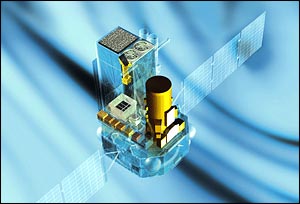will photograph the sky in the fields of gamma radiation, X-ray and visible light
 A Russian rocket launched from Baikonur in Kazakhstan carried with it a new European satellite that will actually serve as a small space telescope. It is designed to observe and locate black holes while combining observation in three wavelengths - gamma radiation, X-ray and visible light. It will observe not only exotic black holes but also giant stars as they explode as supernovae, neutron stars, pulsars and gamma-ray bursts.
A Russian rocket launched from Baikonur in Kazakhstan carried with it a new European satellite that will actually serve as a small space telescope. It is designed to observe and locate black holes while combining observation in three wavelengths - gamma radiation, X-ray and visible light. It will observe not only exotic black holes but also giant stars as they explode as supernovae, neutron stars, pulsars and gamma-ray bursts.
The satellite's name, Integral, is derived from the phrase INTenational Gamma Ray Astrophysics Laboratory. It will reach full operational activity within a few weeks.
Gamma rays are high-energy light rays. One of the great mysteries of science today are the bursts of gamma rays that cross the sky from different sources at the rate of one per day, and they disappear after a few seconds. No one can predict when such an outbreak will occur and where it will come from.
The role of the satellite will be to locate these eruptions quickly and then notify within 30 seconds to astronomers around the world, so that other telescopes can be directed to the same area to try to extract more details. Another task that will be assigned to the satellite will be to study the formation of the chemical elements. Hydrogen and helium were formed in the Big Bang, but the heavier atoms were formed inside stars.
As mentioned, Integral is a project of the European Space Agency, but the Russians launched it for free on a Proton model rocket in exchange for an observation time of thirty percent of the day, for Russian astronomers.
The manufacturer of the satellite under contract for the European Space Agency is Alanya Aerospazio of Turin, Italy. Prof. Giorgio Palumbo from the University of Bologna in Italy, a senior scientist in the project is convinced that the satellite will work properly. In an interview with the BBC, he said that he hopes to see a supernova explosion in the relatively close vicinity, so that it can be studied by satellite. Large supernovae are seen only once every few decades or even hundreds of years, and the light of the last one reached us in 1987.
John Kardland, director of the space science project at the European Space Agency, says that the satellite may provide new insights into the theory of relativity as well as discover many black holes, which are known to be the source of gamma rays, and study their behavior.
The scientific instruments cost about 160 million dollars and the spacecraft itself costs three times that amount. Control of the spacecraft will be from the European Control Center (Esoc) in Darmstadt, Germany. The life of the satellite is expected to be at least two years.
